
This shape can be supported by a kick-up pad. If you cannot find this style of shoulder pad consider using shaped sleeve heads or a rolled pad.

In this pattern photo you can clearly see the edge of the shoulder pad. It appears to be shaped like modern women's wear 'coat pads'. It features a steep increase from the inner to outer edge, and lets the sleeve hang straight down below the modest puff.
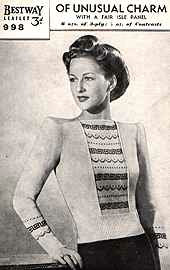
A roll or long rectangular pad (see gauge swatch pads) should be used when the sleeve seam sits this far from the neck and the puff extends the shoulder line.

The line of this 1950s shoulder is improved by a round pad. Although the welt features drastic shaping (presumably full fashioned increases) the sleeve and shoulder are very basic. The pad creates the shape and adds drape to the heavy fabric. This is the kind of 'figure enhansing' padding that Dior re-introduced.
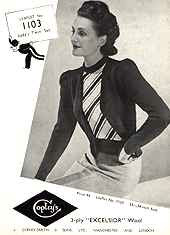
Another kick-up shape. Any kick-up shoulder pad, whether it is a pad or layered, angled sleeve head, needs to be customized and carefully placed. In this case most of the shaping comes from the fabric type and pleating. The padding supports, rather than creates the shape.

To support the apex of this folded puff sleeve, a triangular pad or a modern shoulder pad. trimmed to shape should work. When the shoulder line is extended to this extreme, consider stitching the pad so that the greater portion of padding is free of the shoulder. Try flipping a triangular pad so that the point sits at the centre of the sleeve to shoulder seam, and that the long side sits at the edge of the shoulder.
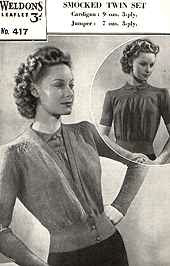
Without some sort of pad a cardigan or any kind of second layer would flatten a delicately puffed sleeve jumper. In this example the pad would most likely have been knit as a small rectangular (almost square) pillow, stuffed with fleece or maybe sawdust. A clever home knitter might have used her gauge squares!
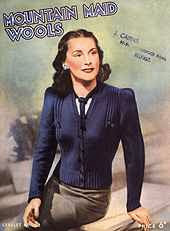
Remember that a sturdier knit may not require a shoulder pad. Often, a dense or thick fabric can support it's own puffed up weight, so long as it has been properly gathered or pleated before seaming into the armseye.
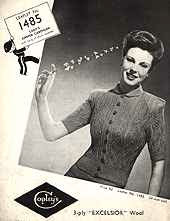
This pattern photo clearly shows the outline of a shoulder pad. It is shaped much like todays shaped pads and is a handy reference for padding placement. It will have been stitched down the centre spine, with small tacking stitches taken at the two side points of the pad, securing it to the front and the back of the sweater.

'For When You're Off Duty ' is an uncommonly accommodating pattern. The pattern includes direction of a custom shoulder pad. Despite the dense fabric created by pleating the firm 1x1 ribbing of the sleeve, this elongated shoulder line would not stay aloft without it's padding.
You are reading "The Quest For Puff" ©Morgan Forrester
Up next:
Choosing & Placing Knitted Shoulder Pads
Coming Soon:
Vintage Sleeves: Puff Pleating
Vintage Sleeves: Seaming for Puff
Creating Puffed Sleeves Anew
This post is a part of The Quest For Puff Series. Read it from the beginning HERE.



2 comments:
When you made the 'Deco Sweater' and used the 'For When You're Off Duty' pattern, did you make the shoulder pads?
I didn't. The shoulders in that sweater didn't do what I wanted them too. It's partially why I started this series. They would benefit from a shoulder pad now. Hey! Maybe I'll use that sweater as an example when I talk about sleeve heads. Thanks Kayla!
Post a Comment